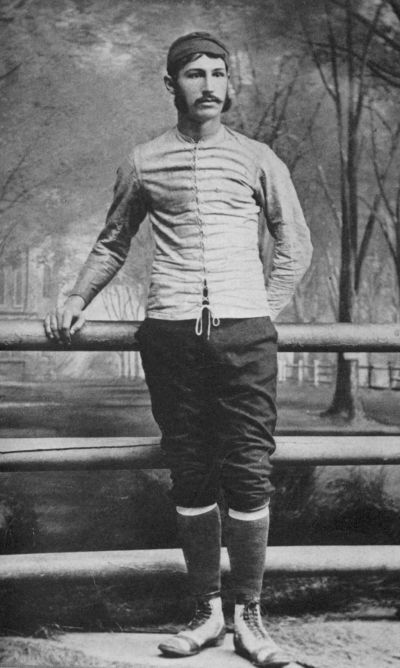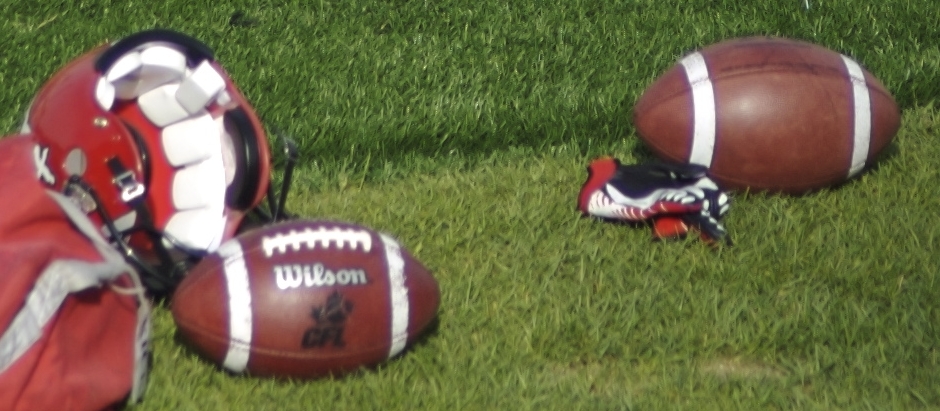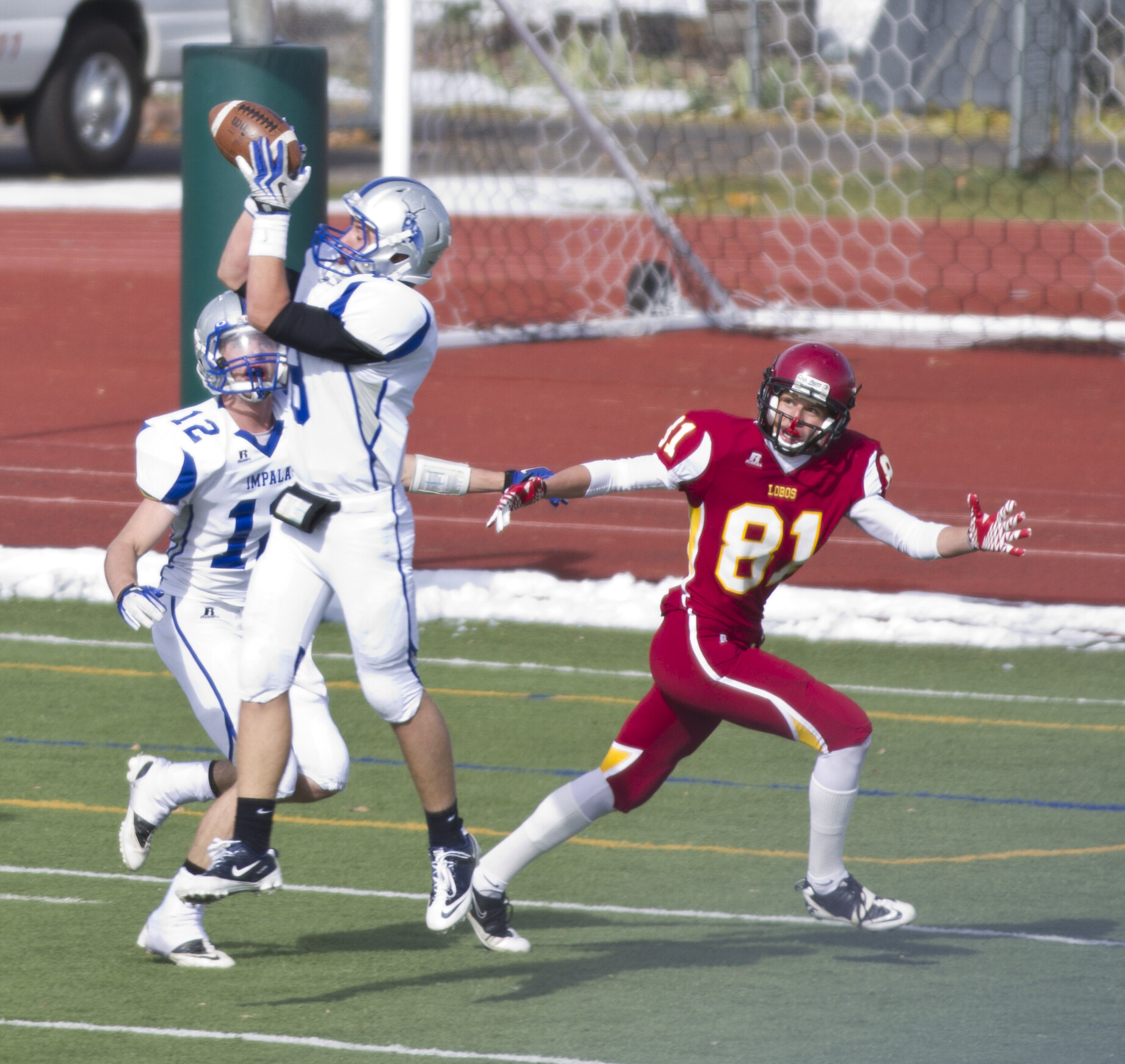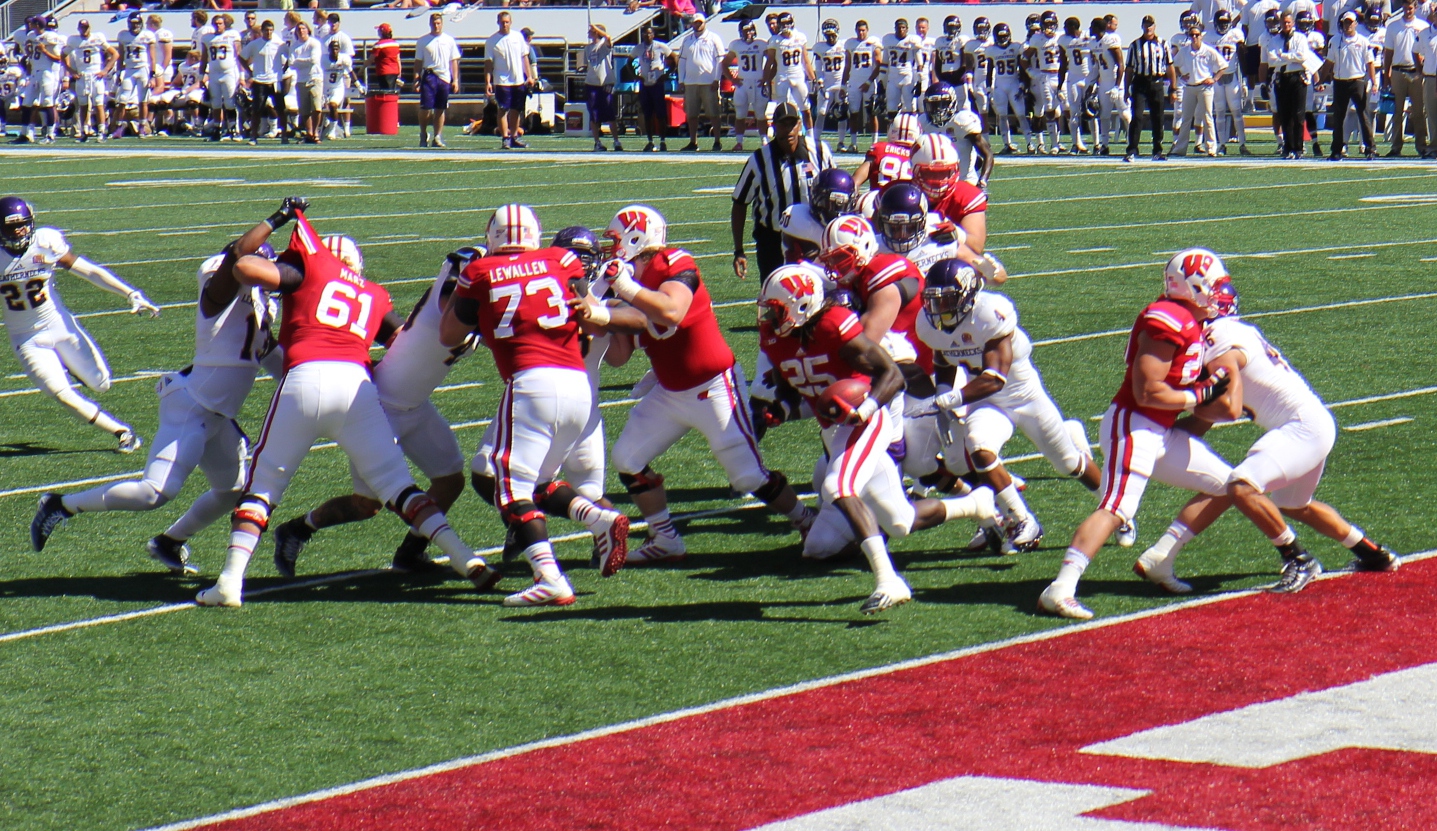|
Pass Interference
In American and Canadian football, pass interference (PI) is a foul that occurs when a player interferes with an eligible receiver's ability to make a fair attempt to catch a forward pass. Pass interference may include tripping, pushing, pulling, or cutting in front of the receiver, covering the receiver's face, or pulling on the receiver's hands or arms. It does not include catching or batting the ball before it reaches the receiver. Once the ball touches any defensive player or eligible offensive receiver, the above rules no longer apply and the defender may tackle the receiver or attempt to prevent them from gaining control of the ball. Once a forward pass is in the air it is a loose ball and thus any eligible receiver – all defensive players are eligible receivers – may try to catch it. When a defensive player catches a forward pass it is an interception and their team gains possession of the ball. Some actions that are defined as pass interference may be overlooked if ... [...More Info...] [...Related Items...] OR: [Wikipedia] [Google] [Baidu] |
|
 |
American Football
American football, referred to simply as football in the United States and Canada and also known as gridiron football, is a team sport played by two teams of eleven players on a rectangular American football field, field with goalposts at each end. The offense (sports), offense, the team with possession of the oval-shaped Ball (gridiron football), football, attempts to advance down the field by Rush (gridiron football), running with the ball or Forward pass#Gridiron football, throwing it, while the Defense (sports), defense, the team without possession of the ball, aims to stop the offense's advance and to take control of the ball for themselves. The offense must advance the ball at least ten yard, yards in four Down (gridiron football), downs or plays; if they fail, they turnover on downs, turn over the football to the defense, but if they succeed, they are given a new set of four downs to continue the Glossary of American football#drive, drive. Points are scored primarily b ... [...More Info...] [...Related Items...] OR: [Wikipedia] [Google] [Baidu] |
 |
Canadian Football
Canadian football, or simply football, is a Sports in Canada, sport in Canada in which two teams of 12 players each compete on a field long and wide, attempting to advance a Ball (gridiron football), pointed oval-shaped ball into the opposing team's end zone. Canadian and American football, American football have shared origins and are closely related, but have some major comparison of American and Canadian football, differences. Canadian football is played with three downs, goalposts in the front of the endzone, and twelve players on each side. Comparatively, American football has four downs, goalposts in the back of the endzone, and eleven players on each side. Canadian football is also played on a bigger field. Rugby football, from which Canadian football developed, was first recorded in Canada in the early 1860s, taken there by British immigrants, possibly in 1824. Both the Canadian Football League (CFL), the sport's top professional league, and Football Canada, the go ... [...More Info...] [...Related Items...] OR: [Wikipedia] [Google] [Baidu] |
|
Eligible Receiver
In gridiron football, not all players on offense are entitled to receive a forward pass: only an eligible pass receiver may legally catch a forward pass, and only an eligible receiver may advance beyond the neutral zone if a forward pass crosses into the neutral zone. If the pass is received by a non-eligible receiver, it is "illegal touching" (resulting in a penalty of five yards and loss of down). If an ineligible receiver is beyond the neutral zone when a forward pass crossing the neutral zone is thrown, a foul of " ineligible receiver downfield" (resulting in a penalty of five yards, but no loss of down) is called. Each league has slightly different rules regarding who is considered an eligible receiver. College football The NCAA rulebook defines eligible receivers for college football in Rule 7, Section 3, Article 3. The determining factors are the player's position on the field at the snap and their jersey number. Specifically, any players on offense wearing numbers betwe ... [...More Info...] [...Related Items...] OR: [Wikipedia] [Google] [Baidu] |
|
 |
Forward Pass
In several forms of football, a forward pass is the throwing of the ball in the direction in which the offensive team is trying to move, towards the defensive team's goal line. The legal and widespread use of the forward pass distinguishes gridiron football (American football and Canadian football) from rugby football (rugby union, union and rugby league, league) from which the gridiron code evolved, in which the play is illegal. Illegal and experimental forward passes had been attempted as early as 1876, but the first legal forward pass in American football took place in 1906, after a change in the rules. Another rule change on January 18, 1951, established that no center or guard could receive a forward pass, and a tackle may only do so if he announces his intent to the referee beforehand that he will be an eligible receiver, called a tackle-eligible play. The only Lineman (gridiron football), linemen who can receive a forward pass are the ends (tight ends and wide receivers). ... [...More Info...] [...Related Items...] OR: [Wikipedia] [Google] [Baidu] |
 |
Interception
In Ball game, ball-playing Competitive sport, competitive team sports, an interception or pick is a move by a player involving a pass of the ball—whether by foot or hand, depending on the rules of the sport—in which the ball is intended for a player of the same team but caught or otherwise brought under control by a player of the opposing team, who thereby usually gains possession of the ball for their team. It is commonly seen in football, including American football, American and Canadian football, as well as association football, rugby league, rugby union, Australian rules football and Gaelic football, as well as any sport by which a loose object is passed between players toward a goal. In basketball, this is called a Steal (basketball), steal. Gridiron football In American football and Canadian football, an interception occurs when a forward pass that has not yet touched the ground is caught by a player of the defensive team. This leads to an immediate change of possess ... [...More Info...] [...Related Items...] OR: [Wikipedia] [Google] [Baidu] |
 |
National Football League
The National Football League (NFL) is a Professional gridiron football, professional American football league in the United States. Composed of 32 teams, it is divided equally between the American Football Conference (AFC) and the National Football Conference (NFC). The NFL is one of the major professional sports leagues in the United States and Canada and the highest professional level of American football in the world. Each NFL season begins annually with a NFL preseason, three-week preseason in August, followed by the NFL regular season, 18-week regular season, which runs from early September to early January, with each team playing 17 games and having one Bye (sports), bye week. Following the conclusion of the regular season, seven teams from each conference, including the four division winners and three Wild card (sports), wild card teams, advance to the NFL playoffs, playoffs, a single-elimination tournament, which culminates in the Super Bowl, played in early February ... [...More Info...] [...Related Items...] OR: [Wikipedia] [Google] [Baidu] |
|
Screen Pass
A screen pass is a play in gridiron football consisting of a short pass to a receiver who is protected by a screen of blockers. During a screen pass, a number of things happen concurrently in order to fool the defense into thinking a long pass is being thrown, when in fact the pass is merely a short one, just beyond the defensive linemen. Screens are usually deployed against aggressive defenses that rush the passer. Because screens invite the defense to rush the quarterback, they are designed to leave fewer defensive players behind the rushers to stop the play. Use A screen pass can be effective, but it can also be risky as it is rather easy for a defensive player, even a lineman, to interception, intercept the pass if a defender gets between the quarterback and the intended receiver—something that only happens if the offensive line misses a block, the quarterback takes too long to throw or the defense blitz (gridiron football), overwhelms the offensive line. If the pass is inte ... [...More Info...] [...Related Items...] OR: [Wikipedia] [Google] [Baidu] |
|
|
Line Of Scrimmage
In gridiron football, a line of scrimmage is an invisible transverse line (across the width of the field) beyond which a team cannot cross until the next play has begun. Its location is based on the spot where the ball is placed after the end of the most recent play and following the assessment of any penalty yards. History The line of scrimmage first came into use in 1880. Developed by Walter Camp (who introduced many innovations that are part of the modern game of American football), it replaced a contested scrimmage that had descended from the game's rugby roots. This uncontested line of scrimmage would set into motion many more rules that led to the formation of the modern form of gridiron football (although the Canadian rules were developed independently of the American game, despite their similarities). Dimensions A line of scrimmage is parallel to the goal lines and touches one edge of the ball where it sits on the ground before the snap. In American football, ... [...More Info...] [...Related Items...] OR: [Wikipedia] [Google] [Baidu] |
|
 |
Canadian Football League
The Canadian Football League (CFL; , LCF) is a Professional gridiron football, professional Canadian football league in Canada. It comprises nine teams divided into two divisions, with four teams in the East Division (CFL), East Division and five in the West Division (CFL), West Division. The CFL is the highest professional level of Canadian football in the world. The league is headquartered in Toronto. The CFL was officially established on January 19, 1958, upon the merger between the Interprovincial Rugby Football Union or "Big Four" (founded in 1907) and the Western Interprovincial Football Union (WIFU) (founded in March 1936). The Big Four was renamed the Eastern Football Conference in 1960, while the WIFU was renamed the Western Football Conference in 1961. , the league features a 21-week season (sport), regular season in which each team plays 18 games with 3 bye (sports), bye weeks. The season traditionally runs from mid-June to early November. Following the regular seas ... [...More Info...] [...Related Items...] OR: [Wikipedia] [Google] [Baidu] |
 |
Glossary Of American Football
The following terms are used in American football, both conventional and indoor. Some of these terms are also in use in Canadian football; for a list of terms unique to that code, see '' Glossary of Canadian football''. 0–9 A B C D E F G H I J K A punt, place kick, or drop kick L M N O P ... [...More Info...] [...Related Items...] OR: [Wikipedia] [Google] [Baidu] |
|
Professional Foul
''Professional Foul'' is a television play written by Czech-born, British playwright Tom Stoppard. It was broadcast on 21 September 1977 in BBC 2's ''Play of the Week'' series. The play is set in Prague and follows the character of Professor Anderson, a Cambridge ethics don, on a weekend visit to a philosophical colloquium. What should be a fairly uneventful trip is complicated by the intervention of the Communist government, leading to an ethical dilemma for the professor of philosophy, a situation explored by Stoppard through the opinions of several characters. The play was written to coincide with Amnesty International's "Prisoners of Conscience Year" and is dedicated to Czech playwright Václav Havel, then periodically imprisoned by the Czech Communist authorities. Stoppard has cited Havel as an influence on his writing. In the year of publication and broadcast the Charter 77 movement in Czechoslovakia presented the government with a formal protest against its violatio ... [...More Info...] [...Related Items...] OR: [Wikipedia] [Google] [Baidu] |
|
 |
Running Interference
In American football, blocking or interference (or running interference) involves legal movements in which one player uses his body to obstruct another player's path. The purpose of blocking is to prevent defensive players from tackling the ball carrier, or to protect a quarterback who is attempting to pass, hand off or run the ball. Offensive linemen and fullbacks tend to do the most blocking, although wide receivers are often asked to help block on running plays and halfbacks may be asked to help block on passing plays, while tight ends perform pass blocking and run blocking if they are not running routes to receive passes. Overall, blocking is a skill that virtually every football player may be required to do at some point, even defensive players in the event of a turnover. Essentially, blocking is pushing, with certain restrictions; in blocking one may not grasp another player or do any sort of pulling, and the hands must not extend beyond the line of each armpit; otherwise ... [...More Info...] [...Related Items...] OR: [Wikipedia] [Google] [Baidu] |